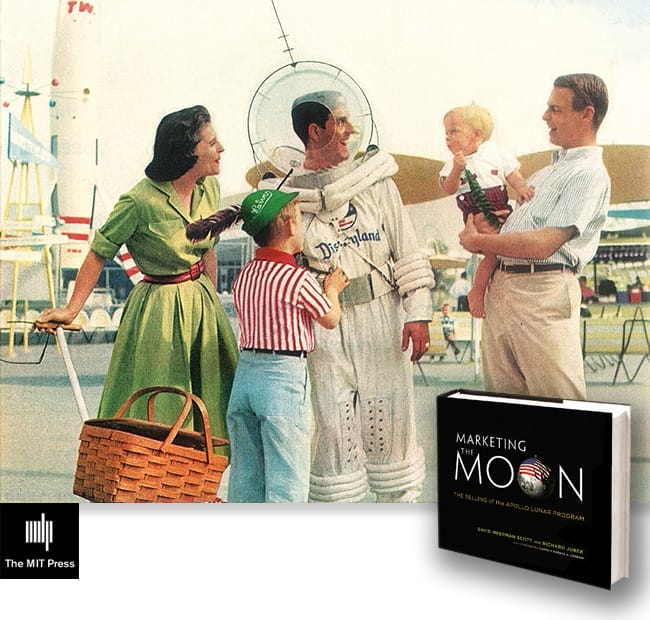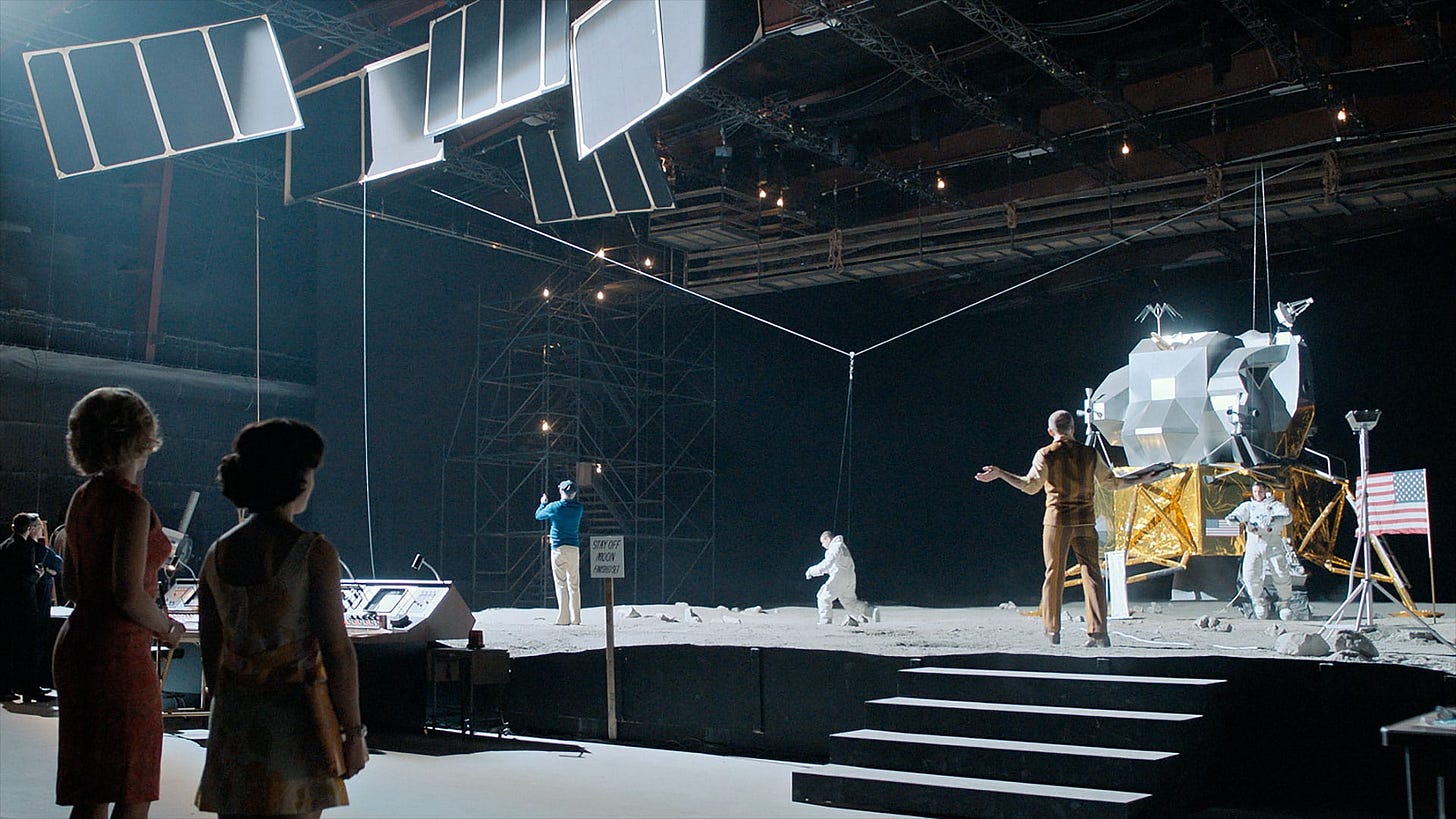Fly Me to the Moon with Conspiracy Theories
The film "Fly Me to the Moon" both celebrates the 1969 Moon landing and delves into the conspiracy theories that emerged afterward. Explore this historical narrative in the context of two significant world transits: Jupiter-Uranus and Saturn-Neptune.
"Will they make history...or fake it?" This is the meta-question that the recently released film Fly Me to the Moon explores through its semi-fictional depiction of the Apollo 11 mission. Why meta? Because this question resonates not only with the archetypal energies of the 1960s Space Race and the conspiracy theories that followed the Moon landing, but with our current moment as well.
The plot revolves around Kelly Jones (Scarlett Johansson), a sharp-witted marketing specialist, and Cole Davis (Channing Tatum), the dedicated NASA launch director, who are thrown together during the height of the 1960s Space Race. With the pressure of the Apollo 11 mission mounting, Kelly is brought in to boost NASA's public image. However, her assignment takes a curious turn when she and Cole are tasked with developing a contingency plan: creating a fictionalized version of the Moon landing to be used in the event that the actual mission fails. As they work closely to prepare this "backup" scenario, a complex relationship unfolds between them, blending professional tension with growing personal affection.
The film does an excellent job of capturing the current Jupiter-Uranus and Saturn-Neptune alignment through its playful portrayal of one of history's greatest achievement (Jupiter-Uranus) and the doubts (Saturn-Neptune) it continues to evoke.
It is no coincidence that the film was partially based on David Meeran Scott and Richard Jurek's illustrated book Marketing the Moon which was published in February 2014 during both, a Jupiter-Uranus and Saturn-Neptune alignment. Thus, this film concretizes three diachronic moments: the late 60s, mid 2010s, and early 2020s through the archetypal lens of Jupiter-Uranus and Saturn-Neptune.
Adventurous Innovation: Jupiter Uranus and Moon Landings
In 1969, the world witnessed an extraordinary feat of human ingenuity and ambition: the first crewed mission to the Moon. This momentous event occurred during a Jupiter-Uranus conjunction, an astrological transit associated with groundbreaking discoveries, peak experiences, technological advancements, and a collective yearning for progress. Here is a short article about the history of Moon landings and Jupiter-Uranus alignments:
Jupiter-Uranus & Moon Landings
Planetary alignments unfold into collective consciousness in the form of archetypes. On archetypes, Richard Tarnas writes: "In effect, planetary archetypes are considered to be both “Jungian” (psychological) and “Platonic” (metaphysical) in nature: universal essences or forms at once intrinsic to and independent of the human mind, that not only endure as timeless universals but are also cocreatively enacted and recursively affected through human participation."
The reason we witness a reverberation of history lies in the mystery of planetary archetypes. While the moon landing occurred in 1969, we experience echoes of it throughout history (e.g., in 2014 with the book Marketing the Moon and in early 2024 with Anti Social Social Club and NASA's streetwear collaboration). Planetary archetypes are reflected in the metaphors we use, popular artistic movements, policy decisions, and more. The list is endless.
Anti Social Social Club x NASA: A Streetwear Tribute to the Moon Landing
The Fog of Doubt: Saturn-Neptune and Conspiracy Theories
Although the Moon landing represented a triumph of collective will and scientific achievement, it was soon followed by a wave of skepticism and conspiracy theories that questioned the authenticity of the event. This surge of doubt has typically coincided with Saturn-Neptune alignments which tend to express societal confusion, disillusionment, and the blurring of boundaries between fact and fiction. The initial seeds of doubt were planted almost immediately after the Moon landing as political drama unfolded in the US:
1972 (Saturn-Neptune opposition): President Nixon's Watergate scandal eroded public trust in the government and increased skepticism about official narratives like the Moon landing.
1976 (Saturn-Neptune trine): Bill Kaysing self-published a book titled We Never Went to the Moon: America's Thirty Billion Dollar Swindle. This book triggered a massive wave in conspiracy theories surrounding the Moon landing.
1980 (Saturn-Neptune square): The Flat Earth Society had incorporated Moon landing hoax claims into their broader skepticism about space exploration and scientific evidence. They argued that the Moon landing was staged as part of a larger conspiracy to deceive the public and maintain the illusion of space travel.
2001 (Saturn-Neptune trine): The documentary, Conspiracy Theory: Did We Land on the Moon? and the film A Funny Thing Happened on the Way to the Moon were released, infusing the collective with further doubt and skepticism.
Despite overwhelming scientific evidence supporting the authenticity of the Apollo 11 mission, these theories continue to capture public imagination, often driven by a broader distrust of institutions and a fascination with alternative narratives.
So it seems like perfect cosmological timing for the film Fly Me to the Moon to bring this historical narrative of scientific achievement and its doubts back into collective consciousness. In a creative and witty manner, the film honors both the fact and fiction of the Moon landing.
Navigating Murky Territory
While the current Jupiter-Uranus conjunction is coming to a close, the Saturn-Neptune transit will continue until 2027, just as the next major Jupiter-Uranus alignment begins. So, over the next several years, we may witness a resurgence in conspiracy theories and a general mistrust of established narratives, possibly influenced by events similar to the Watergate scandal.
That being said, the alignment between Saturn and Neptune presents an opportunity for deeper self-reflection and a re-evaluation of our relationship with truth and reality. So as this transit unfolds, remember to:
Invoke Saturn–stay grounded: Focus on practical, tangible aspects of your life.
Embrace Neptune–be flexible: Adapt to changing circumstances as they arise.
Balance Neptune's idealism with Saturn's realism: Pursue your dreams, but set realistic goals.
Integrate Saturn-Neptune–practice mindfulness: Be present and aware to your thoughts and feelings.
Clarify Saturn-Neptune: When faced with confusion, take time to reflect and seek understanding.
And of course, if you haven't already...watch Fly Me to the Moon. Feel the brilliant glow of Jupiter-Uranus as the transit enters its "sunset" phase, and begin to swim in the murky but calm territory of Saturn-Neptune:








